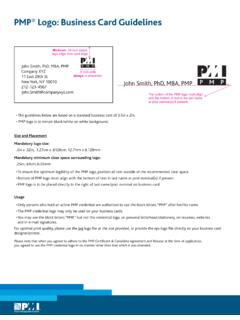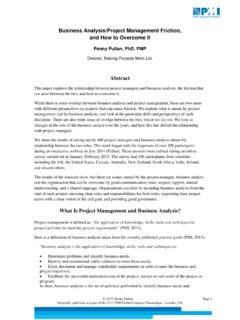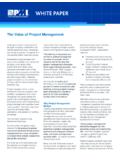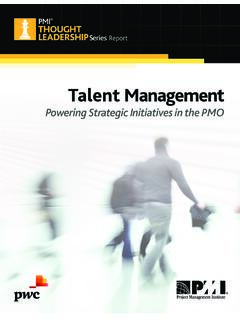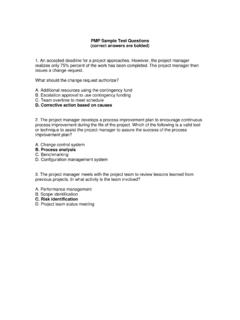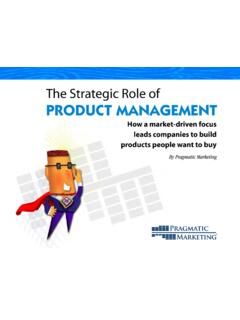Transcription of Executive Engagement: The Role of the Sponsor
1 Executive Engagement: the role of the Sponsor Too often, the term project Sponsor conjures up the image of a disconnected Executive whose main responsibility is to secure the project funds and then come in for the victory lap when it is all over. But an engaged Executive Sponsor with a vested business interest in the project from kickoff to close can mean the difference between success and failure. Indeed, one of the most common reasons why projects fall short is a lack of Executive sponsorship and management buy-in, according to the KPMG New Zealand Project Management Survey In addition, PMI s 2010 Government Program Management Study found that 81 percent of program managers at government agencies said that strong support from at least one Executive -level Sponsor had a high impact on project According to Diego Nei, project portfolio manager at CEACRE, a not-for-profit institution in Salvador, Brazil, the Sponsor s key responsibilities include.
2 Providing clear direction for the project and how it links with the organization s overall strategy Securing project resources Ensuring the project is on time, on budget and on scope Providing feedback on status reports and making sure they reach the necessary stakeholders Championing the project at the Executive level to secure buy-in Despite the strategic importance of the role , the KPMG survey found that 68 percent of companies do not always have an effective Sponsor . In many cases, they are simply too busy. Sponsors typically have a day job, too often a demanding one, says David West, senior technical director at engineering firm WSP, London, England. Not devoting sufficient time to the project is a common failing. But that could be a fatal error. The project Sponsor has as big an influence on the outcome of the project as the project manager, says Terry Cooke-Davies, PhD, group chairman at consultancy Human Systems International, London, England, and author of Aspects of Complexity: Managing Projects in a Complex World [PMI, 2011].
3 In an increasingly competitive marketplace marked by economic fluctuations, project sponsors cannot afford to take a hands-off approach. The recession and global competition have forced everyone to focus only on the top priorities, says Mike Haran, PMP, PgMP, program manager at businesses services group Experian, Chicago, Illinois, USA. Sponsors are under continuous pressure to deliver better results with fewer resources. This means that an Executive s commitment is even more important now than before. The Sponsor versus the Project Manager Because the Executive Sponsor and the project manager will ideally be working closely from start to finish, both need a clear understanding of their roles . They must see themselves as compatible members of a project team, says Dr. Cooke-Davies. Each needs the other. It cannot be the Executive sponsors seeing themselves as the project manager s boss.
4 That way lies ruin. Dr. Cooke-Davies suggests sponsors and project managers put together an emotional contract that covers: The time commitment each can expect from the other The frequency and nature of reports from the project manager How often they will meet How the Sponsor expects the project manager to deal with problems and when they will be escalated to the Sponsor Once guidelines are in place, it is up to the Sponsor to walk the fine line between being a vested party and a micromanager. Dr. Cooke-Davies says sponsors have to be very clear that they are not a project manager. Sponsors have to let the project managers manage the project and create the environment to allow them to do that. Instead of always turning to the Sponsor , project managers should be encouraged to make many of the day-to-day calls on their own. Project managers can t spend most of their lives providing information to the Sponsor so they can make a decision that the project manager should be making, he says.
5 Each person has his or her own part to play. A Sponsor and a project manager have different roles : The Sponsor authorizes the project, the project manager executes the project, says Dennis Creech, director of North American professional services and project management at Cincom Systems Inc., Cincinnati, Ohio, USA. A Sponsor who gets involved in the details of the daily execution of the project has crossed that line and makes it difficult for the project manager to fulfill their role. More than one person running a project causes confusion for everyone and jeopardizes the project. The best sponsors make themselves available to the project manager and encourage communication, whether the news is good or bad. The best rule of thumb is no surprises, Dr. Cooke-Davies says. Talk openly about the project risks. The Project: The Organization: WSP, London, England The Sector: Construction and Engineering The ROI: Strong sponsorship brought diverse stakeholders together to create a project plan that made business sense for everyone.
6 When David West, senior technical director at engineering firm WSP, came on as a Sponsor for the 132 million project to revamp Edinburgh Waverly train station in Scotland s capital, a full array of stakeholders was ready to take action. The only problem was that each of them had their own vision for how the project would unfold. There was little doubt about the need. The United Kingdom s largest train station outside of London was operating at maximum capacity during peak traveling hours, causing congestion and wear-and-tear on facilities. In 2004, the overhaul kicked off. The first part of the project called for developing longer platforms, remodeling stations to take advantage of the new platform capacity, and adding new escalators and elevators. The next stage, which includes building the escalators and lifts at the Waverly Steps entrance, is currently in progress and scheduled for completion in 2012.
7 Although the Scottish government is the primary investor, several key stakeholders could have helped or hindered the project. For example, Mr. West explains, the City of Edinburgh Council was keen to see major improvements that would enhance the station s image as a gateway to the city. The council also has the power to grant planning permissions for various aspects of the project. And Network Rail, which owns the station, was working on a major upgrade of the Edinburgh signaling center at the same time. The agency came in with its own plans for a much larger scheme but lacked the funding to deliver it. One of the biggest sticking points was a planned retail deck over the entire station. It was an ambitious goal and completely unaffordable. That meant Mr. West had to find an acceptable middle ground. My sponsorship challenge was to develop an affordable scheme which had sufficient benefits to be attractive to all the stakeholders and which did not preclude further development in the future, Mr.
8 West says. Mr. West first set up a project steering group with representation from all major stakeholders. The steering group was the forum where all key stakeholders met and debated the issues, he says. This was where the competing aspirations were reviewed, analyzed and gradually whittled down to the one option that all stakeholders wanted to see delivered. He then created a table stake setting out the joint objectives, to be signed by each stakeholder representative. Ultimately, the retail deck was scrapped, but a 28,000-panel glass roof got the go-ahead. As the owners of the project business case and guardians of the investor s interests, project sponsors must be the ones to secure buy-in from every stakeholder. The Executive Sponsor has to take diverse and often competing stakeholder interests and negotiate a common ground that all stakeholders can agree on and collaborate to deliver, he says.
9 The Executive Sponsor s job is to do this so as to deliver maximum possible value to the investor and negotiate the option with the best business case. Once the Sponsor sorts out each stakeholder s desires and demands, he or she must then communicate to the project manager what needs to be delivered to meet those goals and then let the project manager oversee the details. In the end, the renovation project was launched in a much shorter time period, and remains largely on schedule and under budget. It illustrates the importance of stakeholder management and finding the common ground, Mr. West says. The Sponsor As Translator the role of the Sponsor starts at the very origin of the project. Not only do sponsors lead the project through the selection process until it is formally authorized, they also play a crucial role in the development of the initial scope and charter.
10 The first duty of the project Sponsor is to define the project, says WSP s Mr. West. The project Sponsor identifies what the project must achieve and defines the project that will deliver that. This requires a good understanding of how the organization operates and of the corporate strategy. Once the project s organizational goals are defined, the Sponsor must translate that vision into clearly understood deliverables for the project manager and team, Mr. West says. But most project sponsors do not devote enough time explaining how the project aligns with the overall strategy, says James Brown, PMI-SP, PMP, PgMP, senior manager, research program management office at agronomy company Pioneer Hi-Bred International, Des Moines, Iowa, USA. And that can create what Mr. Haran calls ambiguity poisoning what the project manager suffers from when he or she cannot clearly understand what the Executive is asking for.
